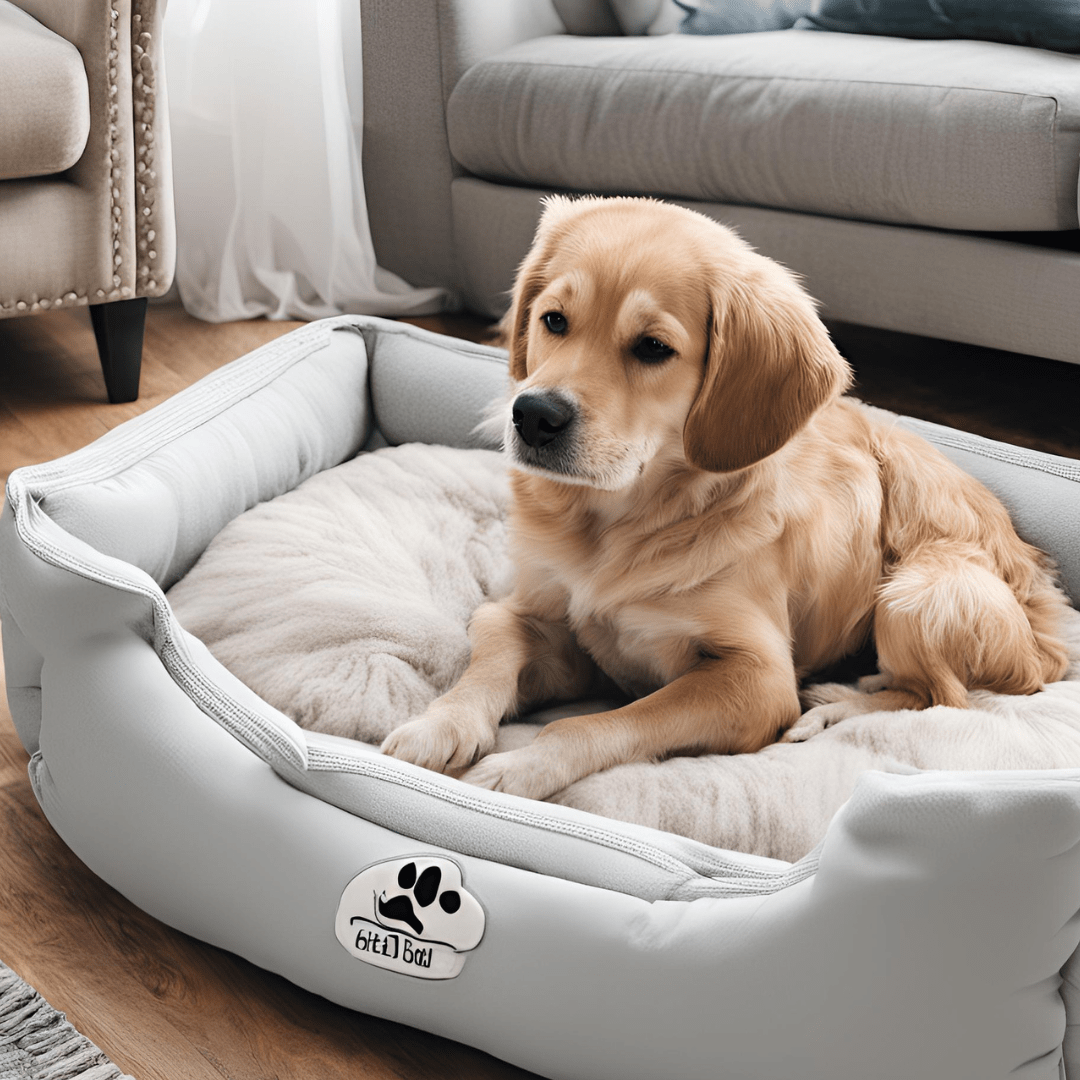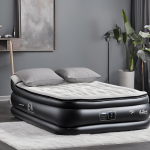
To wash a Dog Bed, remove the cover and wash it in a washing machine with pet-safe detergent. Air dry or use a low heat setting.
Keeping your dog’s bed clean ensures their comfort and health. A dirty bed can harbor bacteria, allergens, and pests that may harm your pet. Regular washing not only eliminates odors but also extends the life of the bed. Start by checking the manufacturer’s instructions on the care label.
Most bog beds have removable covers that can be machine-washed. Use a gentle cycle with cold water and pet-safe detergent to avoid skin irritation. After washing, air dry the cover or use a low heat setting in the dryer. For the inner cushion, spot clean or hand wash as required. Regular cleaning keeps your dog’s resting area fresh and hygienic.
Choosing The Right Dog Bed
Washing a dog bed keeps your furry friend happy and healthy. But choosing the right dog bed is just as important. A suitable bed ensures comfort, support, and easy maintenance.
Consider Your Dog’s Size
Your dog’s size plays a crucial role in selecting the right bed. A small bed won’t suit a large dog, and a big bed might not be cozy for a small dog.
Small dogs need beds where they can curl up comfortably. A bed that’s too large will feel cold and unwelcoming. Look for beds with raised sides for extra comfort.
Medium-sized dogs benefit from beds that offer enough room to stretch out. Ensure the bed isn’t too small or too large, as either can cause discomfort.
Large dogs require beds that provide ample space and support. Look for beds with thick padding or memory foam to support their joints.
| Dog Size | Recommended Bed Size |
|---|---|
| Small (up to 25 lbs) | 20 to 30 inches |
| Medium (25 – 50 lbs) | 30 to 40 inches |
| Large (50 – 100 lbs) | 40 to 60 inches |
Measure your dog from nose to tail to ensure the bed size is right. Add a few inches to this measurement for comfort.
Selecting The Material
The material of the dog bed affects comfort, durability, and ease of cleaning. Machine-washable materials are the best choice for easy maintenance.
Cotton is soft and breathable, making it ideal for dogs with sensitive skin. It’s also easy to clean but may wear out faster.
Fleece provides warmth and comfort, perfect for colder climates. Fleece beds are also easy to wash but may attract hair and dust.
Memory foam beds offer excellent support for dogs with joint issues. These beds are durable but may require spot cleaning or a removable cover.
- Microfiber: Soft, durable, and easy to clean.
- Nylon: Water-resistant and durable, great for outdoor use.
- Polyester: Affordable and easy to clean but may not be as durable.
Consider your dog’s habits when selecting the material. If your dog likes to chew, choose a durable fabric. If they have allergies, opt for hypoallergenic materials.
Removable covers make cleaning easier. Look for beds with zippers or Velcro closures for hassle-free washing.
Choose the right material to ensure your dog’s bed stays clean, comfortable, and durable.
Preparing For Washing
Washing a dog bed is crucial for maintaining a clean and healthy environment for your furry friend. Preparing for washing ensures that you can effectively clean the bed without damaging it. Follow these steps to get your dog bed ready for a thorough wash.
Remove Any Removable Covers
Start by removing any removable covers from the dog bed. Many dog beds come with covers that can be easily taken off, making the cleaning process simpler. Here’s how you can do it:
- Unzip or unfasten the cover from the bed.
- Shake the cover outside to remove loose dirt and hair.
- Place the cover in a laundry basket for easy transport.
Removing the cover allows you to clean both the cover and the bed itself more thoroughly. If the bed does not have a removable cover, you will need to wash the entire bed.
Benefits of removing covers include:
| Benefit | Description |
|---|---|
| Easy Cleaning | You can wash the cover separately in a machine. |
| Better Hygiene | Removes accumulated dirt and pet hair. |
| Prolongs Bed Life | Prevents wear and tear on the main bed. |
Always check for any hidden zippers or buttons that may secure the cover. Removing covers also helps you spot any stains or damage that need special attention.
Check Washing Instructions
Before you start washing, check the washing instructions on the dog bed label. Different materials require different cleaning methods. Here’s a quick guide:
- Machine Washable: Most covers can be machine washed. Use a gentle cycle with cold water.
- Hand Wash Only: For delicate fabrics, hand washing is safer. Use mild detergent and lukewarm water.
- Dry Clean: Some luxury dog beds may need dry cleaning. Take them to a professional cleaner.
Reading the label ensures you don’t accidentally damage the bed. Important tips to remember:
- Use pet-safe detergent to avoid skin irritation.
- Avoid bleach as it can weaken the fabric.
- Use a lint roller to remove hair before washing.
Some beds have a special filling that requires particular care. Check if the filling can be washed or needs spot cleaning. Following the washing instructions helps maintain the bed’s quality and extends its lifespan.
By carefully removing covers and checking washing instructions, you ensure your dog’s bed stays clean and in good condition. This preparation makes the washing process smoother and more effective.
Handwashing The Dog Bed
Keeping your dog’s bed clean is essential for their health and comfort. Handwashing the dog bed ensures a thorough cleaning without damaging the fabric. It’s perfect for beds with delicate materials or intricate designs. Let’s dive into the process of handwashing your dog’s bed, focusing on spot cleaning stains and using mild detergent.
Spot Cleaning Stains
Stains can make your dog’s bed look unsightly and harbor bacteria. Spot cleaning is a quick fix for these issues. Follow these steps for effective spot cleaning:
- Identify the stained areas on the dog bed.
- Use a damp cloth to blot the stain gently.
- Apply a mixture of water and mild detergent to the stain. Avoid harsh chemicals.
- Gently scrub the area with a soft brush or cloth.
- Rinse the spot with clean water to remove detergent residue.
- Blot the area dry with a clean towel.
Here’s a simple table to help you with the spot cleaning mixture:
| Ingredient | Quantity |
|---|---|
| Water | 1 cup |
| Mild Detergent | 1 teaspoon |
Repeat the process if the stain persists. Always test the mixture on a small area first to ensure it doesn’t harm the fabric.
Using Mild Detergent
A mild detergent is safe for your dog’s skin and the bed’s fabric. Follow these steps to handwash the entire bed:
- Fill a large basin with lukewarm water.
- Add a small amount of mild detergent to the water. Stir to mix well.
- Submerge the dog bed completely in the soapy water.
- Gently agitate the bed to loosen dirt and debris.
- Use a soft brush to scrub any heavily soiled areas.
- Rinse the bed thoroughly with clean water to remove all soap.
- Squeeze out excess water gently. Avoid wringing the bed to prevent damage.
- Lay the bed flat on a clean surface to air dry. Ensure it’s completely dry before use.
Handwashing with mild detergent keeps the bed fresh and hygienic. It ensures your dog has a comfortable and clean place to rest.
Machine Washing The Dog Bed
Washing a dog bed in a machine saves time and ensures a thorough clean. It removes dirt, fur, and odors efficiently.
Follow these steps to machine wash your dog’s bed and keep it fresh and hygienic:
Selecting The Right Cycle
Choosing the correct cycle for washing a dog’s bed is crucial. It ensures the bed is cleaned without causing damage. Here are some tips:
- Gentle Cycle: Most dog beds benefit from a gentle cycle. It protects the fabric and stuffing.
- Warm Water: Warm water helps kill bacteria and remove dirt. Avoid hot water as it may shrink or damage the bed.
- Extra Rinse: Use an extra rinse cycle to remove all detergent. Dogs can be sensitive to soap residue.
Check the dog bed’s care label for specific instructions. Some beds may require special care. If the bed is large, consider using a commercial washer. Home machines might not handle bulky items well.
Consider using a washing machine with a high spin speed. It helps remove more water, reducing drying time. Here’s a quick reference table for cycle settings:
| Cycle | Water Temperature | Spin Speed |
|---|---|---|
| Gentle | Warm | High |
| Normal | Cold | Medium |
Adding Pet-safe Laundry Detergent
Using pet-safe detergent is essential for your dog’s health. Regular detergents contain chemicals that can irritate your dog’s skin. Look for these features in pet-safe detergents:
- Hypoallergenic: Prevents allergic reactions and skin irritation.
- Fragrance-Free: Strong scents can bother dogs and cause discomfort.
- Non-Toxic: Safe for pets if they chew on the bed.
Follow the detergent’s instructions for the correct amount to use. Too much detergent can leave residue, even with an extra rinse. Pet-safe detergents are available in most pet stores and online. Here are some popular brands:
| Brand | Features |
|---|---|
| Arm & Hammer | Hypoallergenic, fragrance-free |
| Seventh Generation | Non-toxic, eco-friendly |
| Nellie’s All-Natural | Hypoallergenic, biodegradable |
Always double-check the detergent label. Ensure it is safe for pets and follow the recommended usage. This keeps your dog’s bed clean and safe.
Drying The Dog Bed
Washing your dog bed is essential to keep it clean and fresh. Drying the dog bed properly ensures it remains comfortable and free from mold. In this section, we will explore two methods to dry your dog bed: air drying and using a low heat setting in the dryer.
Air Drying
Air drying is a gentle way to dry your dog bed. This method helps preserve the fabric and padding. Follow these steps to air dry your dog bed:
- Shake off excess water: After washing, shake the dog bed to remove as much water as possible.
- Find a sunny spot: Place the dog bed in a sunny area. Sunlight helps kill bacteria and speeds up drying.
- Use a drying rack: Lay the dog bed flat on a drying rack. This allows air to circulate the bed.
- Flip and fluff: Flip the bed every few hours. This ensures even drying and prevents damp spots.
Air drying can take longer, but it’s worth it for delicate materials. Remember, patience is key. Avoid placing the bed in a damp or shaded area. This might lead to mold and mildew growth.
Using A Low Heat Setting In The Dryer
Using a dryer can speed up the drying process. It is important to use a low heat setting to avoid damaging the bed. Follow these steps:
- Check the care label: Before drying, read the care label on your dog bed. Ensure it is dryer-safe.
- Set the dryer: Choose a low heat or delicate setting on your dryer. High heat can damage the fabric and padding.
- Add dryer balls: Place a few dryer balls in the dryer with the dog bed. They help fluff the bed and reduce drying time.
- Monitor the drying process: Check the dog bed every 20 minutes. This prevents overheating and ensures even drying.
Using a low heat setting in the dryer is efficient and convenient. Make sure the bed is completely dry before use. A damp bed can be uncomfortable for your dog and may lead to odor and bacteria growth.
Dealing With Odors
Washing your dog’s bed isn’t just about cleanliness. Dealing with odors is crucial. A smelly dog bed can make your home less inviting. Let’s explore effective ways to tackle these odors and keep your dog’s bed fresh and clean.
Sprinkling Baking Soda
Baking soda is a natural odor eliminator. It’s safe for dogs and works wonders on smelly beds. Follow these steps to use baking soda effectively:
- Remove loose dirt: Shake out the bed to get rid of loose dirt and hair.
- Sprinkle generously: Spread a generous amount of baking soda over the entire surface of the bed.
- Let it sit: Allow the baking soda to sit for 15-20 minutes. This gives it time to absorb odors.
- Vacuum: Use a vacuum to remove the baking soda from the bed. Make sure to get into all the crevices.
For extra freshness, you can mix a few drops of essential oil with the baking soda before sprinkling it. Lavender and chamomile are great choices as they are safe for dogs and have a calming effect.
| Steps | Details |
|---|---|
| Remove Loose Dirt | Shake out the bed to get rid of loose dirt and hair |
| Sprinkle Generously | Spread a generous amount of baking soda over the entire surface |
| Let It Sit | Allow the baking soda to sit for 15-20 minutes |
| Vacuum | Use a vacuum to remove the baking soda from the bed |
Using Odor-neutralizing Spray
Odor-neutralizing sprays are another effective solution. These sprays are formulated to eliminate odors rather than mask them. Here’s how to use them:
- Choose the right spray: Select an odor-neutralizing spray that’s safe for pets. Look for products with natural ingredients.
- Test first: Spray a small amount on a hidden area of the bed to test for any adverse reactions.
- Spray evenly: Hold the spray bottle about 6-8 inches from the bed and apply an even coat over the entire surface.
- Let it dry: Allow the bed to air dry completely before letting your dog use it again.
For best results, use the spray in a well-ventilated area. Repeat this process weekly or as needed to keep the bed smelling fresh.
Combining baking soda and an odor-neutralizing spray can provide a double layer of odor protection. Your dog’s bed will not only look clean but also smell fresh, making it a more pleasant place for your furry friend to rest.
Maintaining The Dog Bed
Keeping your dog’s bed clean is crucial for your pet’s health and comfort. Maintaining the dog bed ensures it remains a cozy and hygienic spot for your furry friend. Regular maintenance can extend the life of the bed, making it a worthwhile investment. Below, we discuss how to maintain a dog bed effectively.
Regular Washing Schedule
Establishing a regular washing schedule for your dog’s bed is essential. Frequent washing removes dirt, allergens, and odors. Here’s a simple guide to follow:
- Weekly Wash: Wash the bed cover and any removable cushions once a week.
- Monthly Deep Clean: Perform a thorough cleaning of the entire bed, including the filling, every month.
Here’s a table to summarize the washing schedule:
| Task | Frequency |
|---|---|
| Wash Bed Cover | Weekly |
| Deep Clean the Entire Bed | Monthly |
Always check the care label for washing instructions. Use a gentle detergent to avoid skin irritation. Ensure the bed is completely dry before use to prevent mold growth. Consider using a pet-safe fabric spray for added freshness.
Fluffing And Flattening
Regular fluffing and flattening of the dog bed helps maintain its shape and comfort. Here are some tips:
- Daily Fluffing: Give the bed a quick fluff each day to redistribute the filling.
- Weekly Shake-Out: Shake out the bed to remove loose dirt and debris.
If the bed has memory foam or other special padding, follow these steps:
- Remove the cover and any removable parts.
- Shake out the foam or padding.
- Gently stretch and reshape the foam to its original form.
A quick table to illustrate the fluffing schedule:
| Task | Frequency |
|---|---|
| Daily Fluffing | Daily |
| Weekly Shake-Out | Weekly |
Regular fluffing prevents the bed from becoming lumpy. This keeps your pet comfortable and supports their joints. Make it a part of your routine to ensure a cozy resting spot for your dog.
Final Tips
Washing your dog bed keeps your pet healthy and your home clean. Following a few final tips ensures the bed stays in top condition after each wash. These tips help maintain the bed’s longevity and hygiene.
Brushing Off Loose Hair Before Washing
Before washing your dog’s bed, remove as much loose hair as possible. This step prevents hair from clogging your washing machine and ensures a thorough cleaning.
Here are a few methods to brush off loose hair:
- Use a lint roller: Quickly roll it over the bed to pick up hair.
- Brush with a pet hair brush: Gently brush the surface to gather loose strands.
- Shake the bed outdoors: Give it a good shake to dislodge hair and debris.
- Vacuum: Use a handheld vacuum to suck up hair from the bed’s surface.
For stubborn hair, try these tips:
| Method | Instructions |
|---|---|
| Rubber gloves | Wear damp gloves and run your hands over the bed to gather hair. |
| Sticky tape | Wrap sticky tape around your hand, sticky side out, and press on the bed. |
Removing hair before washing saves time and keeps your washing machine functioning well.
Inspecting For Damage
Before washing, inspect the dog bed for any damage. This step helps you avoid further wear and tear during the wash.
Check for these common issues:
- Torn fabric: Look for tears or holes that could worsen in the wash.
- Loose seams: Check seams for any loose threads or gaps.
- Damaged zippers: Ensure zippers are functioning and not broken.
- Stuffing: Examine if the stuffing is intact and not spilling out.
If you find any damage, consider these solutions:
- Repair small tears: Sew small tears or holes before washing.
- Replace zippers: Fix or replace broken zippers to avoid further damage.
- Secure loose seams: Stitch loose seams to prevent further unraveling.
- Re-stuff: Add more stuffing if needed to maintain the bed’s shape.
Inspecting for damage ensures the bed stays in good condition and lasts longer.
Frequently Asked Questions
Is It Okay To Wash A Dog Bed In The Washing Machine?
Yes, you can wash a dog bed in the washing machine. Check the care label first. Use mild detergent and cold water.
How To Wash A Dog Bed With Stuffing?
Remove the cover and wash it separately. Check care instructions for machine wash or hand wash clean stuffing with mild detergent. Rinse thoroughly and dry completely. Use a pet-safe disinfectant if needed.
How Do Wash A Dog Bed With A Removable Cover?
Remove the cover and check the label for washing instructions. Wash it in cold water with mild detergent. Tumble dry on low or air dry. Clean the bed’s interior with a vacuum or spot-clean as needed. Reassemble once both parts are fully dry.
How Do You Wash A Dog Bed That Can’t Go In The Washer?
Spot clean with a mixture of mild detergent and water. Use a brush to scrub gently. Rinse with clean water. Air dry completely. For odors, sprinkle baking soda, let sit, then vacuum.
Conclusion
Keeping your dog’s bed clean is essential for your pet’s health and comfort. Regular washing removes dirt, allergens, and pests. Always follow the care instructions on the label. Use pet-safe detergents and thoroughly dry the bed. A clean bed ensures a happy, healthy dog and a fresher home environment.








